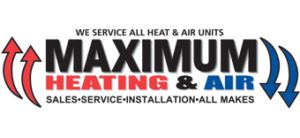What to Do When The Air Conditioner Stops Working
From Maximum Heating and Air in Chattanooga, TN
It is never fun when an air conditioner suddenly stops working, especially in the midst of the southern summer heat. However, it is a mistake to automatically assume that the system is broken or in need of expensive repairs. The solution may be simple enough for the homeowner to fix on their own, or they prefer to call in a professional who can figure out the issue. Here are six steps that should be taken when an air conditioner stops working.
1. Stay Calm
First of all, remember to stay calm. Not having air conditioning is tremendously unfortunate, but stress can increase your body temperature, making things feel even worse. Remember that even if the homeowner is unable to fix the problem themselves, they can always call the experts at Maximum Heating and Air for reliable service whenever an emergency strikes—including after hours, on the weekend, or on holidays.
2. Check the thermostat
Make sure the thermostat is turned on and set to “cool” rather than “heat.” This may seem simple, but even if the homeowner is certain that it has been set correctly, they should take a moment to check it anyway.
If the thermostat is off, the batteries might be drained. Wall thermostats could take AA, AAA alkaline, or 3V lithium batteries. The batteries need to be changed approximately once a year. A low battery indicator appears on the display when it’s time to replace, but this is often and easily overlooked.
If the homeowner is uncertain about how to replace thermostat batteries, they should consult the owner’s manual for specific instructions regarding that model. In general, the following steps should be followed in order to replace batteries in a thermostat that does not have an external battery compartment:
- Pull the thermostat box off its wall mounted plate
- Turn the box over and use a small screwdriver to open the battery slot
- Discard the old batteries and replace them with new ones;then close the battery slot
- Put the thermostat box back onto the wall mount and slide it down until you hear it snap or click back in place
If the thermostat has an external battery compartment, press down on the top right corner of the thermostat to reveal the compartment. After that, remove the compartment cover to replace the batteries before snapping it back into place.
3. Check the circuit breakers
Power surges, storms, and sweltering temperatures can overload the circuit, turning off the power to the air conditioner. There are two places that need to be checked in order to see what exactly tripped the circuit breaker.
Fuse box/Electrical service panel
An electrical service panel serves as the switchboard operating center for all the electricity in a home. In an older home built before 1960, a fuse box serves the same purpose. In both cases, these components receive incoming power and distribute that power to each circuit that controls items such as appliances, light switches, and air conditioners.
The electrical service panel or fuse box is usually found in the garage or in a utility closet. A tripped breaker is easy to spot; while the other breakers will be switched to the “on” position, a tripped one will be switched to “off.” Wait thirty minutes before turning back on the air conditioner after switching on the breaker. If the breaker immediately trips again, the homeowner then needs to work with a professional to determine the cause. The problem could be:
- Fan-motor malfunctions
- Refrigerant leaks
- Compressor problems
- Frozen evaporator coil
- Loose wiring or electrical component failure
A/C Disconnect
Also known as a switch box or fuse box, an A/C disconnect can be found outside the home, close to the outdoor A/C unit. The same conditions that cause indoor circuit breakers to trip can cause the switches in the A/C disconnect to trip as well. While it is safe to flip the switches in a home’s electrical service panel, attempting to do the same for an A/C disconnect is dangerous. If the homeowner suspects that the A/C disconnect has been tripped, they should consult an HVAC technician or an electrician.
4. Check The Air Conditioner Drain Pan
An air conditioner does more than just cool a home. It also dehumidifies by drawing heat and moisture from the air. This humidity turns into condensation which can then back up in a drain pan connected to the indoor portion of the air conditioner. Some air conditioners automatically shut off when the condensate line becomes clogged. Other signs of clogs include:
- Water leakage coming from the ceiling or attic
- Stained ceiling or walls
- A muggy, humid feeling in your home
- Unfamiliar or unpleasant smells due to mold/algae buildup
A wet/dry vacuum, garden hose, or natural mixture of vinegar and hydrogen peroxide can break up clogs.
5. Contact a Professional
When the homeowner has reached the end of these troubleshooting tasks, it is then time to call in the professionals. A broken air conditioner is an HVAC emergency, and time is of the essence—especially during the heat of summer. Maximum Heating and Air’s emergency services include support on weekends and holidays at no additional cost. This is their way of ensuring that they will always be there when homeowners need them.
6. Consider a Replacement
If the air conditioner spends more time broke than operational it is possibly time for its replacement. When important parts fail, and the system continually breaks down, it is often more cost-effective to replace the system altogether than to pursue band-aid solutions and repairs.
While the purchasing of a new air conditioner is a significant investment, it pays off over time. New systems use less energy, create lower energy bills and create a smaller carbon footprint. Additionally, many utility companies and government agencies offer tax credits and rebates that serve as incentives for homeowners to switch to more energy-efficient air conditioners. Reliability, reduced downtime, and less frequent repairs round out the benefits of saying goodbye to an old air conditioner and hello to a new one.
The Air Conditioning Resource: Maximum Heating and Air
Whether a homeowner is dealing with an emergency or looking to upgrade to a new system, they can trust Maximum Heating and Air for a smooth experience. With nearly twenty years of experience in installing, maintaining, and repairing air conditioning systems, they are trusted by clients throughout the Greater Chattanooga area. In order to get started, contact Maximum Heating and Air today at (423) 894-4970.



